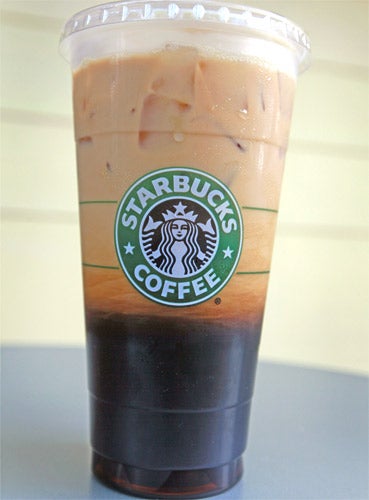The coffee that's bigger than the human stomach

Your support helps us to tell the story
From reproductive rights to climate change to Big Tech, The Independent is on the ground when the story is developing. Whether it's investigating the financials of Elon Musk's pro-Trump PAC or producing our latest documentary, 'The A Word', which shines a light on the American women fighting for reproductive rights, we know how important it is to parse out the facts from the messaging.
At such a critical moment in US history, we need reporters on the ground. Your donation allows us to keep sending journalists to speak to both sides of the story.
The Independent is trusted by Americans across the entire political spectrum. And unlike many other quality news outlets, we choose not to lock Americans out of our reporting and analysis with paywalls. We believe quality journalism should be available to everyone, paid for by those who can afford it.
Your support makes all the difference.Starbucks, the American coffee giant which translated Milan's espresso bars into an identikit global chain serving half pints of coffee-flavoured frothy milk, has launched another innovation: a super-sized cup that contains more liquid than an average human stomach.
Even a nation as obese as the United States expressed surprise at yesterday's introduction of the Trenta receptacle ("Thirty" in Italian), which carries 31 fluid ounces (916ml) in one cup – equivalent to more than an ordinary bottle of wine.
Launched initially in 14 US states, the transparent cup – 63 per cent larger than the chain's previous largest size, the Venti (561ml) – will carry only iced coffee, iced tea and iced-tea lemonade. Starbucks said it was launching the cup in response to demand.
The Seattle-based chain, which has not yet said whether the drink will head across the Atlantic, said its unsweetened drinks would have fewer than 90 calories and sweetened versions fewer than 230.
Its introduction, following Starbucks' decision to drop its name from its redesigned logo earlier this month, prompted one commentator to speculate whether the corporation was going through a mid-life crisis prior to its 40th birthday on 30 March. In mocking animations posted online, zombie customers lurch into Starbucks, staggering out carrying cups larger than their bodies.
The drink's arrival looks like an attempt to increase custom among Americans, the ninth-fattest nation on Earth and the most obese major nation. Fast food and grocery firms there sell an increasing number of super-sized colas and coffees: the grocery chain 7-Eleven has cups called Big Gulps which can carry three pints, while Starbucks' increasingly close competitor, McDonald's, sells ice teas in 32 fluid ounce buckets for $1.
The website HealthHabits described the Starbucks cup's introduction as "a breakthrough for human obesity". It assured readers that, although a Trenta was larger than an average stomach, their stomachs would expand after drinking three or four.
Howard Schultz, Starbucks' chief executive – a tough marketing executive raised in Brooklyn's housing projects who has revived the £7bn-a-year company since returning to the helm in early 2008 – is thought to have been behind the Trenta. Mr Schultz has been behind most of the innovations that have turned the company into a multi-national marketing success.
After a visit to Milan in 1983, as the company's new marketing executive he came up with the idea of recreating state-side the popularity of neighbourhood espressos bars where people stopped to chat and sink milk-less shots. Schultz persuaded senior management, which had been selling coffee beans, to sell fresh coffee and hit on the addition of milk, claiming to have discovered the latte in the Italian city of Verona.
Mr Schultz's borrowing of Italian words to name the drinks sizes has also paid dividends. "Of course not everyone is thrilled to have to use ridiculous-sounding made-up terms just to get a cup of coffee," wrote Taylor Clark in his even-handed history of the company, Starbucked: a Double Tall Tale of Caffeine, Commerce & Culture. "Some customers stick to 'small', 'medium' and 'large' as a display of personal integrity – but Starbucks-speak works." He added: "Consider this: for which of the following options would you be willing to pay more for: a 'grande caffe misto' or a 'medium coffee with milk'?"
To help customers to navigate its complex and – to the uninitiated – bizarre blend of Italian and marketing, Starbucks once published a 22-page booklet to its orders called Make It Your Drink. Writing for the Washington Post, Alexandra Petri described Trenta as sounding like "one of those hip gender-free monikers for kids ('Jayden, meet Trenta')" or a place where a Second World War summit may have taken place. She quoted Mr Schultz's remark in a memo four years ago that Starbucks had lost some "romance and theatre" and that customers lacked an "intimate experience with the barista". "We understand your worries, but this is ridiculous!"Ms Petri wrote. "Now look at you! Changes to appearance! Changes to diet! Next you'll buy a sports car, take up transcendental meditation, and leave us for someone younger!
"I know you feel threatened by McDonald's... doing all the things you used to... but cheaper, and with a taste less like cauterized rubber. But the answer is not to try to become McDonald's."
What's in a name?
Starbucks has three main sizes: Tall (354ml – more than half a pint); Grande (473ml), and Venti (561ml – one pint).
The new size, Trenta, is 916ml, or more than one and a half pints. The names are Italian: Grande meaning large, Venti is twenty (the cup is 20 fluid ounces), and Trenta is thirty – for a cup containing 31 fluid ounces. Starbucks trademarked Venti, prompting coffee consultant Bruce Milletto to say: "One day I expect to pick up La Repubblica and learn that Starbucks has purchased the entire Italian language."
Join our commenting forum
Join thought-provoking conversations, follow other Independent readers and see their replies
Comments